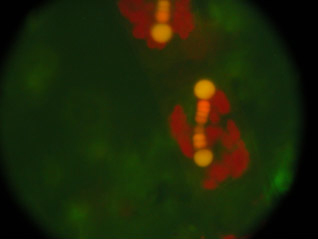Newly discovered ocean bacteria fixes nitrogen instead of carbon
Morgan Erickson-Davis, mongabay.com
November 14, 2008
|
|
A remarkable species of cyanobacteria possessing a unique nitrogen fixation adaptation has recently been discovered in the open ocean, report researchers writing in the November 14th issue of Science.
“Fixation” is the process by which bacteria convert ambient sources of otherwise unusable molecules into compounds necessary for life. Previous to the discovery, carbon was thought of as a necessary accompaniment during fixation because the conversion of carbon dioxide into sugars through photosynthesis provides the necessary energy source for cyanobacteria. It is still unclear how this new species produces its own food, although many microbiologists strongly suspect that a mutually beneficial partnership may exist between the new cyanobacteria and another organism.
“It would make a perfect symbiont because it could feed nitrogen to its host and live on the carbon provided by the host.” said Jonathan Zehr, professor at the University of California, Santa Cruz, and leader of the research team that analyzed the bacteria.
Zehr describes the species as very atypical.
 A chain of Hemiaulus membranaceus diatoms from the Gulf of California which are associated with Richelia intracelluaris symbionts. Note the chloroplast of the diatoms fluoresces red under blue excitation, while the symbiotic cyanobacteria fluoresce yellow and orange. [Image courtesy of Dr. Rachel A. Foster, Ocean Sciences, University of California, Santa Cruz] |
“For it to have such an unusual metabolism is very exciting. We’re trying to understand how something like this can live and grow with so many missing parts.”
In other species of cyanobacteria, photosynthesis is used to convert carbon dioxide to sugars during the day, while nitrogen fixation can only be accomplished at night — or in specialized cells — due to the inhibiting effects of oxygen which is a byproduct of photosynthesis. However, since the new species doesn’t photosynthesize, it can fix nitrogen just as easily during the day, equalling a larger net production of usable nitrogen products than its photosynthetic relatives.
“That has multiple implications,” says Zehr. “It must have a ‘lifestyle’ that’s very different from other cyanobacteria. Ecologically, it’s important to understand its role in the ecosystem and how it affects the balance of carbon and nitrogen in the ocean.”
Zehr and his team sequenced the DNA of the bacteria and found that the genes coding for photosynthetic responses were appropriately missing from its genome. The next steps are to determine its local densities and overall global abundance, and to conduct further study into its unique adaptations. “If it can be cultured, there may be ways to exploit this organism’s unusual metabolism in biotechnology applications” muses Zehr.
Cyanobacteria, otherwise known by the misleading name “blue-green algae”, occupy a hallowed place in the history of life on earth. Fossil evidence of colonial cyanobacteria, called stromatolites, have been found to be as much as 2.8 billion years old, making them among the oldest extant species. They were the first photosynthesizers and are solely responsible for the establishment of the oxygen atmosphere on which most forms of life today depend. All subsequent photosynthesizers owe their existence to cyanobacteria; chloroplasts — the structures by which all plants achieve photosynthesis — are actually evolved forms of endosymbiotic cyanobacteria. Photosynthetic algae are also dependent on their partnerships with this remarkable group of organisms. Yet another unique and important adaptation is the ability of cyanobacteria to fix nitrogen under aerobic (oxygen present) conditions, a role crucial to the existence of modern plants, lichen, and corals.
J.P. Zehr; S. Bench; B.J. Carter; I. Hewson; T. Shi; H.J. Tripp; F. Niazi; J.P. Affourtit. Globally Distributed Uncultivated Oceanic N2-Fixing Cyanobacteria Lack Oxygenic Photosystem II. SCIENCE 14 November 2008